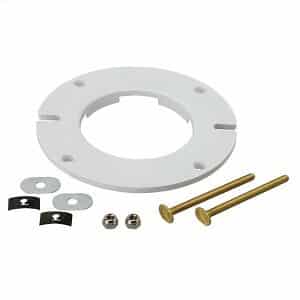How Much Does It Cost to Replace a Toilet Flange?
Last Updated on May 29, 2024
Written by CPA Alec Pow | Content Reviewed by ![]() CFA Alexander Popinker
CFA Alexander Popinker
If you notice any rocking, leaking, or issues with your toilet, the cause may be a damaged or deteriorated toilet flange in need of replacement. But what are the typical parts and labor costs involved in fixing or replacing this important bathroom fixture component?
This comprehensive guide will break down the average costs, factors that can increase pricing, DIY vs professional installation, tips to reduce expenses, real-life cost examples, signs of flange damage, and more. Read on to gain a full understanding of what goes into the cost to properly replace a faulty toilet flange.
Highlights
- Typical costs range $150-$300 for straightforward replacements.
- Severe damage involving subfloors or full toilet replacements can exceed $500+.
- Annual inspections help catch issues early before repairs get expensive.
- Get multiple quotes and consider DIY to reduce costs if skilled.
How Much Does It Cost to Replace a Toilet Flange?
The typical job of toilet flange replacement costs anywhere between $15 and $300, with some more severe cases costing $500+. When budgeting for a basic toilet flange replacement or repair job, expect to account for:
Parts – $10 to $40
- New flange, usually PVC ($5-$20) but sometimes metal ($15-$60)
- Wax seal ring ($5-$10)
- Flange bolts and caps ($1-$5)
- Additional sealants or gaskets ($5-$10)
Labor – $100 to $300
- Plumber’s hourly rate, averaging $50-$150 nationally.
- Time required to replace, typically 1-2 hours.
- Total labor costs ranging from $100-$300.
Additional Expenses – $100+
- Potential subfloor repairs if rotted or damaged ($100-$500).
- Cost of new toilet if flange issue is extensive ($100-$600).
- Disposal fees for old flange and wax ring ($20-$50).
According to Bob Vila, the average cost to replace a toilet flange is around $145 to $165 for parts and labor. This includes the cost of the flange itself, which can range from $7 to $20, depending on the material. The labor cost for a plumber to replace a toilet flange typically falls between $45 and $100 per hour.
Family Handyman provides additional insights into the cost of toilet flange replacement. They mention that the cost can vary depending on the extent of the damage, with a simple replacement costing around $250 to $500. However, if the damage is more extensive, such as requiring subfloor repairs, the cost can increase significantly, potentially reaching thousands of dollars.
This Old House highlights the importance of labor costs in determining the overall cost of toilet flange replacement. They mention that plumbers may charge a flat fee for simple toilet flange replacement rather than billing by the hour, which can affect the total cost.
Housedigest provides a detailed breakdown of the costs involved in replacing a toilet flange. They mention that the cost can range from as little as $5 for a DIY replacement to as much as $380 for a professional installation, depending on the complexity of the job and the materials required. They also emphasize the importance of addressing any underlying issues, such as damaged drain pipes, to avoid additional costs in the long run.
Terry Love Plumbing & Remodel shares a personal experience of a toilet flange replacement, where the cost was $120 for a “normal” install. However, this cost may not be representative of the average cost, as it depends on various factors such as the location and the plumber’s rates.
What is a Toilet Flange?
The toilet flange, also called a closet flange, is a pipe fitting that connects the base of the toilet to the drain pipe running under the floor. It consists of a plastic or metal ring that seals the toilet to the waste drain opening and provides a stable mounting surface.
The flange uses bolts and a wax ring gasket to create a tight seal between the toilet and subfloor. This prevents water leaks and waste gases from escaping. Having a properly sealed, secured flange is extremely important for optimal toilet functioning.
Signs You May Need a Flange Replacement
There are several telltale signs that indicate a deteriorated, misaligned, or damaged toilet flange in need of replacement:
- Visible corrosion or cracks in the flange
- Loose, wobbly toilet or rocking when sat on
- Slow toilet drainage
- Gurgling noises from a poor seal
- New gaps appearing between toilet and floor
- Water leaking between toilet and subfloor
- Rust stains or foul odors from leak
- Loose flange bolts despite retightening
If you notice any of these issues, it likely means the toilet flange has been compromised and should be replaced. Catching problems early prevents more extensive repairs.
You might also like our articles about the cost of an Onyx shower, shower valve replacement, or bath fitter installation.
Factors That Impact Flange Replacement Cost
Several variables affect the total pricing:
- Type of flange material – PVC, cast iron, brass, stainless steel, etc. Specialty parts cost more.
- Extent of damage – Just the flange? Or also subfloor damage? Severity matters.
- Accessibility – Tight spaces make the job harder and require more labor time.
- Regional labor rates – Hourly costs are higher in expensive metro areas.
- Complexity factors – Prior DIY repairs, leaks, rust, etc. complicate the project.
- Overall toilet condition – Replacing the entire toilet adds costs if needed.
The more serious the issues, the higher the cost to remedy them. Annual inspections help catch problems early before they worsen.
DIY vs Hiring a Professional
DIY flange replacement – $50 to $150, mostly for parts if you have the skill.
Hiring a plumber – $200 to $400 typical, including professional labor and materials.
While DIYing can save on labor costs, a plumber’s expertise ensures things are diagnosed and repaired properly the first time. Get multiple quotes before deciding.
Reducing Toilet Flange Replacement Costs
 Recommendations to help control costs include:
Recommendations to help control costs include:
- Annual visual inspections to catch deterioration and minor leaks early.
- Comparing quotes from at least 3 local plumbers to find the best rate.
- Buying replacement flange parts online to save over markups.
- Considering DIY if you have intermediate plumbing skills – but don’t take risks over your skill level.
- Repairing vs replacing only the flange if it is salvageable.
With vigilant maintenance and smart pre-planning, you can avoid costly toilet flange repairs down the road.
Repair vs Replace Your Flange
If the flange is intact but just requires resealing: For minor sealing issues, a $50-$150 flange repair may suffice if the base remains sound. Just redo seals and bolts.
If the flange is corroded, damaged, or misaligned: Full $150-$300+ replacement is likely required for optimal toilet functioning long-term.
Inspection by a professional helps determine whether replacement or repair is the right solution.
Replacement Cost Examples
Here are two examples of real-world flange replacement costs:
Partial Flange Repair in Small Downtown Apartment
Karen notices the toilet in her compact apartment bathroom rocking slightly. The plumber finds:
- Minor corrosion of bolt holes in the cast iron flange.
- Intact wax seal.
To redo the seals, it costs:
- $35 parts – new bolts, metal epoxy sealant.
- $100 labor – 1 hour repair time.
- $135 total charges to solidly re-secure the toilet.
By catching it early before leaks occurred, Karen saved significantly on repairs.
Full Flange and Toilet Replacement in Suburban Home
Dealing with a slow-draining toilet in his 10-year old home’s master bathroom, Lucas calls a plumber who discovers:
- Extensive corrosion and damage to the cast iron flange.
- Decayed subfloor requiring replacement.
To fully remedy the issue, the charges amounted to:
- $225 parts – new flange, wax ring, bolts, plywood, and replacement toilet.
- $450 labor – 3 hours to remove toilet, replace flange and subfloor, reinstall new toilet.
- $75 disposal fees.
- $750 total bill to completely resolve the damaged flange and components.
This emphasises the importance of early leak detection and prevention through vigilant inspections.
Frequently Asked Questions
How long should a toilet flange last?
Most toilet flanges are expected to last 20-30 years with proper installation and maintenance before needing replacement. Proper wax ring seals and keeping bolts tightened extends the lifespan significantly.
Can a damaged flange cause leaks?
Yes, cracks, deterioration, and lack of seal can lead to leaks between the toilet and subfloor over time. Slow leaks can cause unseen water damage if not addressed quickly, resulting in very costly repairs.
Is it necessary to replace the wax ring every time?
The wax ring provides the critical watertight seal between the flange and toilet. It is crucial to install a brand new wax ring whenever you replace the toilet or flange to ensure a solid, leakproof connection. The old ring may have hardened or lost integrity.
What are signs of a bad flange?
Rocking/loose toilet, visible corrosion on the flange, gurgling noises, gaps between the toilet and floor, leaking between toilet and subfloor, loose flange bolts despite retightening, odor, and slow drainage all indicate a damaged flange in need of replacement.
Can I reuse old bolts and wax ring?
It is highly recommended to use all new bolts, nuts, washers, and a fresh wax ring when replacing a flange to guarantee a lasting, sealed connection. The old bolts and wax ring have likely lost integrity over time and may lead to leaks if reused. Spend the few extra dollars on new parts for peace of mind.

Leave a Reply
Want to join the discussion?Feel free to contribute!